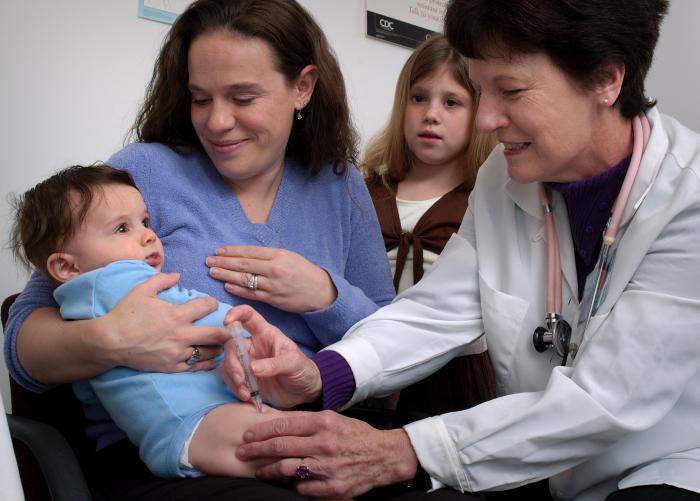The hepatitis B vaccine protects against the hepatitis B virus, which causes liver disease and can lead to cirrhosis, liver failure, or death. It can also cause liver cancer, and this vaccine is the first vaccine that prevents a form of cancer. It is a very mild and safe vaccine with few side effects; it is somewhat controversial because of when it is given; some doubt that it needs to be given to newborns in the hospital, as discussed below.
The Disease
Hepatitis B is a disease caused by the hepatitis B virus; since it is a viral disease, there is no antibiotic or medication to kill the virus and cure the disease. The virus is spread through body fluids, especially blood. It is spread sexually, through sharing of needles used for drug abuse, and through contact with contaminated blood. It can also be spread from pregnant women to their babies during birth. Teenagers and adults most commonly catch it from sexual contact with an infected person; healthcare workers are at risk from exposure to blood and other body fluids. For younger children and infants, the only common risk is from birth.
Often an infected person will have symptoms at first, including nausea, vomiting, diarrhea, fatigue, and possibly jaundice. Most people recover in 1-2 weeks. For many people, that will be the end of the infection. However, some people become chronically infected and continue to carry the virus, even though they have no symptoms. They can spread the virus to other people. Many chronically infected people go on to develop liver damage, cancer, or death from liver failure. There are over a million people in the United States who are chronically infected. Each year, about 200,000 people become infected, and 4,000 to 5,000 people die each year in the U.S.
The Vaccine
The hepatitis B vaccine is made by artificially manufacturing protein particles (antigens) that are on the surface of the virus itself; there is no way to catch the virus from the vaccine. The vaccine became available in 1986, and is effective in 98-100% of people. Several companies make the vaccine, either alone or in combination with other vaccines.
Schedule
The hepatitis B vaccine is given infancy; a total of 3 or 4 doses are needed. The exact number and timing of the doses is somewhat controversial. The vaccine is normally given at birth, and again at 1-4 months and 6-18 months of age. Booster doses are not necessary. The purpose of the birth dose is to prevent transmission from infected mothers to the newborn; however, if the mother is definitely not infected (and moms are almost always tested by their OB as part of their prenatal care), then the baby is not at risk. Some experts therefore view the birth dose as somewhat optional. The issue is more complicated because the hepatitis B vaccine is included in some of the combination vaccines such as Comvax and Pediarix. Each of these is given in 3 doses, so the birth dose can become a 4th, extra dose. This is viewed as acceptable and even preferred under the current U.S. vaccine schedule. Many parents, however, don’t want to give an extra dose or a dose to their newborn that is unnecessary and so opt out of the birth dose at the hospital. This is acceptable as long as the mother has a test that shows that she is not infected with hepatitis B. Some parents also decide to wait to give the vaccine until the child is older, since the primary risk is from sexual contact. However, young children can come in contact with contaminated blood through other means such as biting, accidents, etc. and it seems wisest to go ahead and give the vaccine to infants.
How it is given
The vaccine is injected into the thigh or arm muscle either alone or as part of another combination vaccine. It is safe and effective to give hepatitis B vaccine along with other vaccines the same day, and it is safe and effective to give multiple injections in the same arm or leg.
Side effects
The vaccine causes virtually no side effects. Occasionally there is slight soreness near the injection site; very few children may develop a low grade fever and/or become a little fussy.
Extremely rarely (1 in a million doses), an allergic reaction to any vaccine can occur causing hives and difficulty breathing, which can be treated with medications. The reaction occurs 15-30 minutes after the shot. There are no known deaths in children from an allergic reaction to a vaccine.
Risks vs. benefits
The risks of the vaccine are extremely small, with the side effects noted above. Many people are infected with hepatitis B, and the disease continues to spread from person to person. The benefits outweigh the risks, especially in teens and adults who are at greater risk of the disease.
Resources
Hepatitis B Vaccine Information Statement (VIS) from the CDC
References
A Comprehensive Immunization Strategy to Eliminate Transmission of Hepatitis B Virus Infection in the United States—Part 1: Immunization of Infants, Children, and Adolescents MMWR, December 23, 2005, Vol 54, #RR16
Image public domain courtesy Public Health Information Library/CDC


